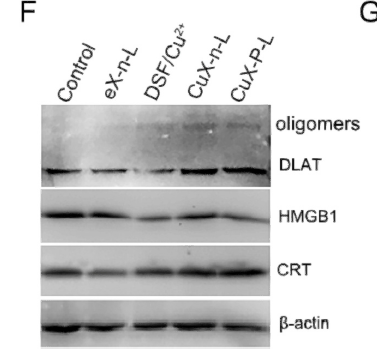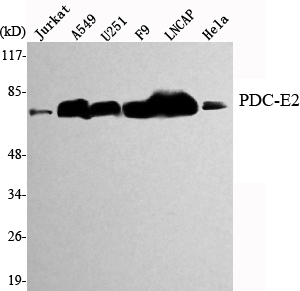
Catalog: YM1328
Size
Price
Status
Qty.
200μL
$450.00
3 weeks
0
100μL
$280.00
3 weeks
0
40μL
$160.00
3 weeks
0
Add to cart


Collected


Collect
Main Information
Target
PDC-E2
Host Species
Mouse
Reactivity
Human, Mouse
Applications
WB, ICC, IP
MW
69kD (Observed)
Conjugate/Modification
Unmodified
Detailed Information
Recommended Dilution Ratio
WB 1:1000; ICC 1:300
Formulation
Liquid in PBS containing 50% glycerol, 0.5% BSA and 0.02% sodium azide.
Specificity
This antibody detects endogenous levels of Pyruvate Dehydrogenase E2 and does not cross-react with related proteins.
Purification
The antibody was affinity-purified from mouse ascites by affinity-chromatography using epitope-specific immunogen.
Storage
-15°C to -25°C/1 year(Do not lower than -25°C)
MW(Observed)
69kD
Modification
Unmodified
Clonality
Monoclonal
Clone Number
20B5
Related Products
Antigen&Target Information
Immunogen:
Purified recombinant human Pyruvate Dehydrogenase E2 protein fragments expressed in E.coli.
show all
Specificity:
This antibody detects endogenous levels of Pyruvate Dehydrogenase E2 and does not cross-react with related proteins.
show all
Gene Name:
DLAT
show all
Other Name:
70 kDa mitochondrial autoantigen of primary biliary cirrhosis ;
anti DLAT ;
Dihydrolipoamide acetyltransferase component of pyruvate dehydrogenase complex ;
Dihydrolipoamide ;
Dihydrolipoamide S Acetyltransferase ;
Dihydrolipoamide S-acetyltransferase ;
E2 component of pyruvate dehydrogenase complex ;
Dihydrolipoamide S-Acetyltransferase ;
Dihydrolipoyllysine-residue acetyltransferase component of pyruvate dehydrogenase complex ;
dihydrolipoyllysine-residue acetyltransferase component of pyruvate dehydrogenase complex mitochondrial ;
DLAT ;
DLAT ;
DLTA ;
E2 ;
E2 component of pyruvate dehydrogenase complex ;
M2 antigen complex 70 kDa subunit ;
M2 Antigen Complex 70kD Subunit ;
mitochondrial ;
ODP2_HUMAN ;
PBC ;
PDC E2 ;
PDC-E2 ;
PDCE2 ;
Pyruvate dehydrogenase complex component E2 ;
Pyruvate dehydrogenase complex E2 subunit ;
S acetyltransferase component of pyruvate dehydrogenase complex.
anti DLAT ;
Dihydrolipoamide acetyltransferase component of pyruvate dehydrogenase complex ;
Dihydrolipoamide ;
Dihydrolipoamide S Acetyltransferase ;
Dihydrolipoamide S-acetyltransferase ;
E2 component of pyruvate dehydrogenase complex ;
Dihydrolipoamide S-Acetyltransferase ;
Dihydrolipoyllysine-residue acetyltransferase component of pyruvate dehydrogenase complex ;
dihydrolipoyllysine-residue acetyltransferase component of pyruvate dehydrogenase complex mitochondrial ;
DLAT ;
DLAT ;
DLTA ;
E2 ;
E2 component of pyruvate dehydrogenase complex ;
M2 antigen complex 70 kDa subunit ;
M2 Antigen Complex 70kD Subunit ;
mitochondrial ;
ODP2_HUMAN ;
PBC ;
PDC E2 ;
PDC-E2 ;
PDCE2 ;
Pyruvate dehydrogenase complex component E2 ;
Pyruvate dehydrogenase complex E2 subunit ;
S acetyltransferase component of pyruvate dehydrogenase complex.
show all
Background:
This gene encodes component E2 of the multi-enzyme pyruvate dehydrogenase complex (PDC). PDC resides in the inner mitochondrial membrane and catalyzes the conversion of pyruvate to acetyl coenzyme A. The protein product of this gene, dihydrolipoamide acetyltransferase, accepts acetyl groups formed by the oxidative decarboxylation of pyruvate and transfers them to coenzyme A. Dihydrolipoamide acetyltransferase is the antigen for antimitochondrial antibodies. These autoantibodies are present in nearly 95% of patients with the autoimmune liver disease primary biliary cirrhosis (PBC). In PBC, activated T lymphocytes attack and destroy epithelial cells in the bile duct where this protein is abnormally distributed and overexpressed. PBC enventually leads to cirrhosis and liver failure. Mutations in this gene are also a cause of pyruvate dehydrogenase E2 deficiency which causes primary lact
show all
Function:
Catalytic activity:Acetyl-CoA + enzyme N(6)-(dihydrolipoyl)lysine = CoA + enzyme N(6)-(S-acetyldihydrolipoyl)lysine.,cofactor:Binds 2 lipoyl cofactors covalently.,Disease:Defects in DLAT are the cause of pyruvate dehydrogenase E2 deficiency [MIM:245348]; also known as lactic acidemia due to defect of E2 lipoyl transacetylase of the pyruvate dehydrogenase complex. Pyruvate dehydrogenase (PDH) deficiency is a major cause of primary lactic acidosis and neurological dysfunction in infancy and early childhood. In this form of PDH deficiency episodic dystonia is the major neurological manifestation, with other more common features of pyruvate dehydrogenase deficiency, such as hypotonia and ataxia, being less prominent.,Disease:Primary biliary cirrhosis is a chronic, progressive cholestatic liver disease characterized by the presence of antimitochondrial autoantibodies in patients' serum. It manifests with inflammatory obliteration of intra-hepatic bile duct, leading to liver cell damage and cirrhosis. Patients with primary biliary cirrhosis show autoantibodies against the E2 component of pyruvate dehydrogenase complex.,Function:The pyruvate dehydrogenase complex catalyzes the overall conversion of pyruvate to acetyl-CoA and CO(2). It contains multiple copies of three enzymatic components: pyruvate dehydrogenase (E1), dihydrolipoamide acetyltransferase (E2) and lipoamide dehydrogenase (E3).,sequence Caution:Contaminating sequence. Sequence of unknown origin in the N-terminal part.,similarity:Belongs to the 2-oxoacid dehydrogenase family.,similarity:Contains 1 lipoyl-binding domain.,similarity:Contains 2 lipoyl-binding domains.,subunit:20 to 30 alpha(2)-beta(2) tetramers of E1 + 6 homodimers of E3 + 60 copies of E2.,
show all
Cellular Localization:
Mitochondrion matrix.
show all
Tissue Expression:
Research Areas:
>>Glycolysis / Gluconeogenesis ;
>>Citrate cycle (TCA cycle) ;
>>Pyruvate metabolism ;
>>Metabolic pathways ;
>>Carbon metabolism
>>Citrate cycle (TCA cycle) ;
>>Pyruvate metabolism ;
>>Metabolic pathways ;
>>Carbon metabolism
show all
Reference Citation({{totalcount}})
Catalog: YM1328
Size
Price
Status
Qty.
200μL
$450.00
3 weeks
0
100μL
$280.00
3 weeks
0
40μL
$160.00
3 weeks
0
Add to cart


Collected


Collect
Recently Viewed Products
Clear allPRODUCTS
CUSTOMIZED
ABOUT US
Toggle night Mode
{{pinfoXq.title || ''}}
Catalog: {{pinfoXq.catalog || ''}}
Filter:
All
{{item.name}}
{{pinfo.title}}
-{{pinfo.catalog}}
Main Information
Target
{{pinfo.target}}
Reactivity
{{pinfo.react}}
Applications
{{pinfo.applicat}}
Conjugate/Modification
{{pinfo.coupling}}/{{pinfo.modific}}
MW (kDa)
{{pinfo.mwcalc}}
Host Species
{{pinfo.hostspec}}
Isotype
{{pinfo.isotype}}
Product {{index}}/{{pcount}}
Prev
Next
{{pvTitle}}
Scroll wheel zooms the picture
{{pvDescr}}






















